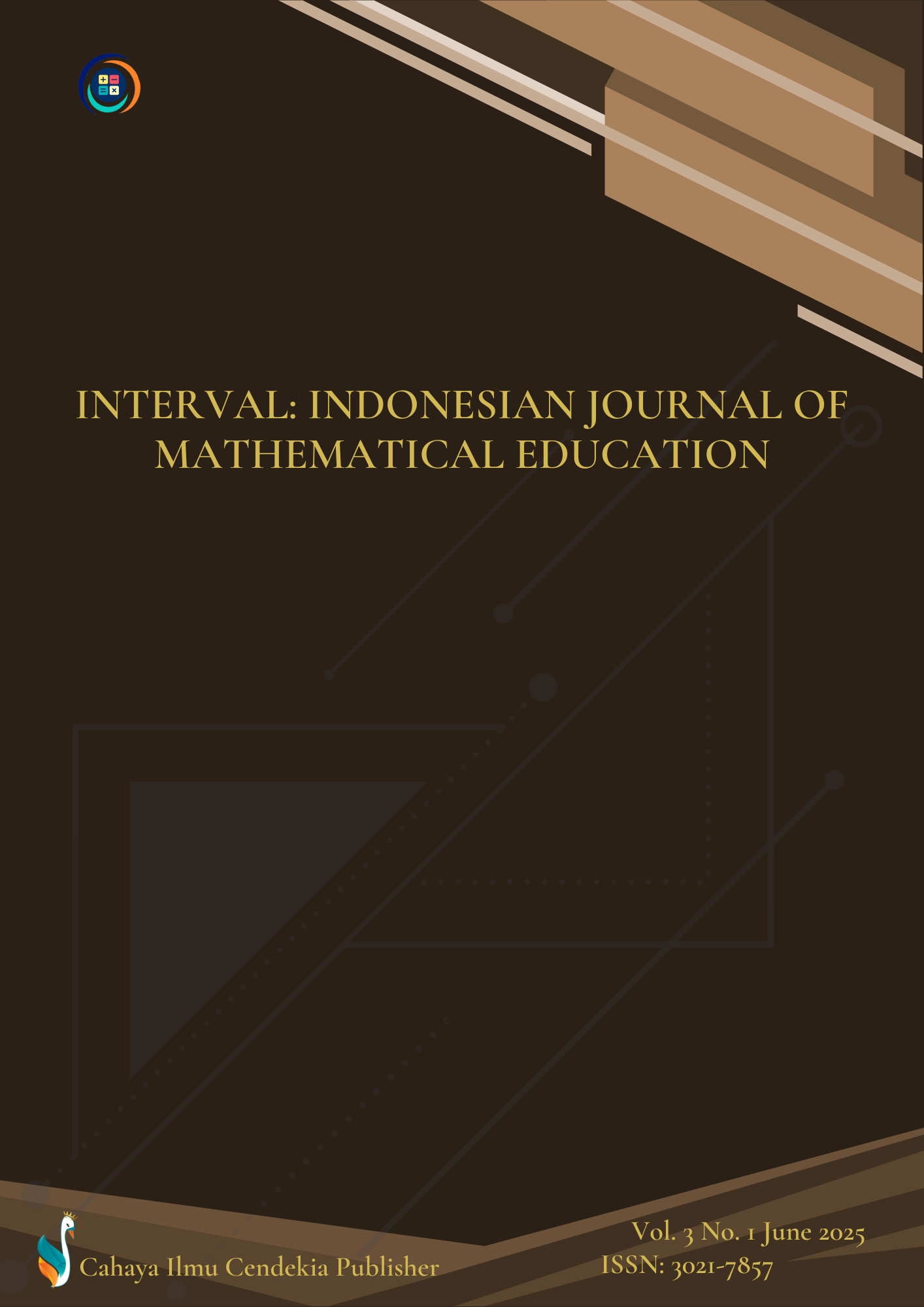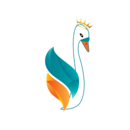Mathematics and Combinatorial Thinking: How Computational Ability Influences Problem-Solving in Number Patterns?
Abstract
Purpose of the study: This study aims to analyze students' computational thinking abilities in solving combinatorial problems based on high, medium, and low ability categories.
Methodology: This study uses a descriptive qualitative approach with subjects of 33 students of class VIII I State Islamic Junior High School 2 Bondowoso. Data were collected through written tests, semi-structured interviews, and documentation. Data analysis used the Miles and Huberman model (reduction, presentation, conclusion) with triangulation techniques for validation, comparing test results, interviews, and documentation.
Main Findings: Students with high and medium computational abilities are able to meet all indicators of computational thinking, including identifying and understanding problems, and converting them into combinatorics. Meanwhile, students with low abilities have difficulty in re-understanding the problems found.
Novelty/Originality of this study: This study provides new insights into how students' level of computational thinking ability influences their success in solving combinatorial problems, as well as offers perspectives in developing more effective learning strategies to enhance students' computational thinking ability.
References
M. Schnieder, S. Williams, and S. Ghosh, “Comparison of in-person and virtual labs/tutorials for engineering students using blended learning principles,” Educ. Sci., vol. 12, no. 3, 2022, doi: 10.3390/educsci12030153.
Y. Zhao and J. Watterston, “The changes we need: education post COVID-19,” J. Educ. Chang., vol. 22, no. 1, pp. 3–12, 2021, doi: 10.1007/s10833-021-09417-3.
K. K. Aggarwal and S. Agrawal, “Artificial intelligence and its role in financial market,” Glob. Financ. Anal. Bus. Forecast., pp. 67–82, 2024.
H. Zhang, I. Lee, S. Ali, D. DiPaola, Y. Cheng, and C. Breazeal, “Integrating ethics and career futures with technical learning to promote ai literacy for middle school students: an exploratory study,” Int. J. Artif. Intell. Educ., vol. 33, no. 2, pp. 290–324, 2023, doi: 10.1007/s40593-022-00293-3.
M. C. Borba, “The future of mathematics education since COVID-19: humans-with-media or humans-with-non-living-things,” Educ. Stud. Math., vol. 108, no. 1–2, pp. 385–400, 2021, doi: 10.1007/s10649-021-10043-2.
T. Dame Adjin-Tettey, “Combating fake news, disinformation, and misinformation: Experimental evidence for media literacy education,” Cogent Arts Humanit., vol. 9, no. 1, 2022, doi: 10.1080/23311983.2022.2037229.
M. W. Habibi, L. Jiyane, and Z. Özşen, “Learning revolution: the positive impact of computer simulations on science achievement in madrasah ibtidaiyah,” J. Educ. Technol. Learn. Creat., vol. 2, no. 1, pp. 13–19, 2024, doi: 10.37251/jetlc.v2i1.976.
S. O. Pela, N. N. Le, P. G. Kaboro, and A. Nurjamil, “Innovation of physics e-module : utilizing local wisdom of Lampung ’ s handwritten batik in teaching heat and temperature material to foster students ’ scientific attitude,” SchrödingerJournal Phys. Educ., vol. 4, no. 4, pp. 132–138, 2023, doi: 10.37251/sjpe.v4i4.924.
R. Sari, I. I. Omeiza, and M. A. Mwakifuna, “The influence of number dice games in improving early childhood mathematical logic in early childhood education,” Interval Indones. J. Math. Educ., vol. 1, no. 2, pp. 61–66, 2023, doi: 10.37251/ijome.v1i2.776.
J. M. P. Sanchez, “Teaching motion concepts through pokémon unite : atudents ’ acceptance and experiences,” SchrödingerJournal Phys. Educ., vol. 5, no. 3, pp. 98–106, 2024, doi: 10.37251/sjpe.v5i3.1076.
M. H. Khoiruddin, Z. Hazmi, Z. Baharin, M. S. Kaka, and S. Saenpich, “Development of visual novel games as learning media for the history of Indonesia ’ s independence,” J. Educ. Technol. Learn. Creat., vol. 1, no. 1, pp. 33–41, 2023, doi: 10.37251/jetlc.v1i1.622.
Y. Yusipa, “Comparative analysis of students’ biology learning outcomes: memory and understanding aspects,” J. Acad. Biol. Biol. Educ., vol. 1, no. 1, pp. 1–9, 2024, doi: 10.37251/jouabe.v1i1.1012.
B. Chen, X. Zhu, and F. Díaz del Castillo H., “Integrating generative AI in knowledge building,” Comput. Educ. Artif. Intell., vol. 5, no. August, p. 100184, 2023, doi: 10.1016/j.caeai.2023.100184.
Y. Huang and S. Wang, “How to motivate student engagement in emergency online learning? Evidence from the COVID-19 situation,” High. Educ., vol. 85, no. 5, pp. 1101–1123, 2023, doi: 10.1007/s10734-022-00880-2.
H. Goss, “Student learning outcomes assessment in higher education and in academic libraries: a review of the literature,” J. Acad. Librariansh., vol. 48, no. 2, p. 102485, 2022, doi: https://doi.org/10.1016/j.acalib.2021.102485.
C. O’Reilly, A. Devitt, and N. Hayes, “Critical thinking in the preschool classroom - A systematic literature review,” Think. Ski. Creat., vol. 46, no. August, 2022, doi: 10.1016/j.tsc.2022.101110.
M. N. Kholid, M. H. Mahmudah, N. Ishartono, F. G. Putra, and B. Forthmann, “Classification of students’ creative thinking for non-routine mathematical problems,” Cogent Educ., vol. 11, no. 1, p., 2024, doi: 10.1080/2331186X.2024.2394738.
E. Tursynkulova, N. Madiyarov, T. Sultanbek, and P. Duysebayeva, “The effect of problem-based learning on cognitive skills in solving geometric construction problems: a case study in Kazakhstan,” Front. Educ., vol. 8, no. December, 2023, doi: 10.3389/feduc.2023.1284305.
A. J. Franco-Mariscal, M. J. Cano-Iglesias, E. España-Ramos, and Á. Blanco-López, The ENCIC-CT Model for the Development of Critical Thinking, vol. 2. 2024. doi: 10.1007/978-3-031-78578-8_1.
R. E. Anggraeni and Suratno, “The analysis of the development of the 5E-STEAM learning model to improve critical thinking skills in natural science lesson,” J. Phys. Conf. Ser., vol. 1832, no. 1, 2021, doi: 10.1088/1742-6596/1832/1/012050.
S. Dolapcioglu and A. Doğanay, “Development of critical thinking in mathematics classes via authentic learning: an action research,” Int. J. Math. Educ. Sci. Technol., vol. 53, no. 6, pp. 1363–1386, 2022, doi: 10.1080/0020739X.2020.1819573.
D. Gudeta, “Professional development through reflective practice: The case of Addis Ababa secondary school EFL in-service teachers,” Cogent Educ., vol. 9, no. 1, 2022, doi: 10.1080/2331186X.2022.2030076.
C. Foster, T. Francome, D. Hewitt, and C. Shore, “Principles for the design of a fully-resourced, coherent, research-informed school mathematics curriculum,” J. Curric. Stud., vol. 53, no. 5, pp. 621–641, 2021, doi: 10.1080/00220272.2021.1902569.
G. Sala-Sebastià, A. Breda, M. J. Seckel, D. Farsani, and À. Alsina, “Didactic–Mathematical–Computational Knowledge of Future Teachers When Solving and Designing Robotics Problems,” Axioms, vol. 12, no. 2, pp. 1–24, 2023, doi: 10.3390/axioms12020119.
R. Prentner, “Mathematized phenomenology and the science of consciousness,” PsyArXiv, 2024, doi: 10.1007/s11097-025-10060-z.
L. Ke, T. D. Sadler, L. Zangori, and P. J. Friedrichsen, “Developing and using multiple models to promote scientific literacy in the context of socio-scientific issues,” Sci. Educ., vol. 30, no. 3, pp. 589–607, 2021, doi: 10.1007/s11191-021-00206-1.
D. Fortus, J. Lin, K. Neumann, and T. D. Sadler, “The role of affect in science literacy for all,” Int. J. Sci. Educ., vol. 44, no. 4, pp. 535–555, 2022, doi: 10.1080/09500693.2022.2036384.
J. Nilimaa, “New examination approach for real-world creativity and problem-solving skills in mathematics,” Trends High. Educ., vol. 2, no. 3, pp. 477–495, 2023, doi: 10.3390/higheredu2030028.
A. Bakker, J. Cai, and L. Zenger, “Future themes of mathematics education research: an international survey before and during the pandemic,” Educ. Mat., vol. 35, no. 2, pp. 9–46, 2023, doi: 10.24844/EM3502.01.
Y. Popova, M. Abdualiyeva, Y. Torebek, N. Yelshibekov, and G. Omashova, “Improving the effectiveness of senior graders’ education based on the development of mathematical intuition and logic: Kazakhstan’s experience,” Front. Educ., vol. 7, no. August, pp. 1–13, 2022, doi: 10.3389/feduc.2022.986093.
M. Q. E. Alfayez, S. Q. A. Aladwan, and H. R. A. Shaheen, “The effect of a training program based on mathematical problem-solving strategies on critical thinking among seventh-grade students,” Front. Educ., vol. 7, no. April, pp. 1–9, 2022, doi: 10.3389/feduc.2022.870524.
L. I. González‐pérez and M. S. Ramírez‐montoya, “Components of education 4.0 in 21st century skills frameworks: systematic review,” Sustain., vol. 14, no. 3, pp. 1–31, 2022, doi: 10.3390/su14031493.
M. Javaid, A. Haleem, R. Pratap Singh, R. Suman, and S. Rab, “Significance of machine learning in healthcare: Features, pillars and applications,” Int. J. Intell. Networks, vol. 3, no. May, pp. 58–73, 2022, doi: 10.1016/j.ijin.2022.05.002.
T. Feraco, D. Resnati, D. Fregonese, A. Spoto, and C. Meneghetti, “An integrated model of school students’ academic achievement and life satisfaction. Linking soft skills, extracurricular activities, self-regulated learning, motivation, and emotions,” Eur. J. Psychol. Educ., vol. 38, no. 1, pp. 109–130, 2023, doi: 10.1007/s10212-022-00601-4.
M. Karimi-Mamaghan, M. Mohammadi, P. Meyer, A. M. Karimi-Mamaghan, and E. G. Talbi, “Machine learning at the service of meta-heuristics for solving combinatorial optimization problems: A state-of-the-art,” Eur. J. Oper. Res., vol. 296, no. 2, pp. 393–422, 2022, doi: 10.1016/j.ejor.2021.04.032.
F. Peres and M. Castelli, “Combinatorial optimization problems and metaheuristics: review, challenges, design, and development,” Appl. Sci., vol. 11, no. 6449, 2021.
K. Suresh, C. Severn, and D. Ghosh, “Survival prediction models: an introduction to discrete-time modeling,” BMC Med. Res. Methodol., vol. 22, no. 1, pp. 1–18, 2022, doi: 10.1186/s12874-022-01679-6.
F. Rodrigues and A. Agra, “Berth allocation and quay crane assignment/scheduling problem under uncertainty: A survey,” Eur. J. Oper. Res., vol. 303, no. 2, pp. 501–524, 2022, doi: https://doi.org/10.1016/j.ejor.2021.12.040.
M. O. Aziza, Dafik, and A. I. Kristiana, “The analysis of the implementation of research-based learning on the students combinatorial thinking skills in solving a resolving perfect dominating set problem,” in Journal of Physics: Conference Series, 2021. doi: 10.1088/1742-6596/1836/1/012057.
V. Ďuriš, G. Pavlovičová, D. Gonda, and A. Tirpáková, “Teaching combinatorial principles using relations through the placemat method,” Mathematics, vol. 9, no. 15, pp. 1–13, 2021, doi: 10.3390/math9151825.
C. Zhang et al., “A review on learning to solve combinatorial optimisation problems in manufacturing,” IET Collab. Intell. Manuf., vol. 5, no. 1, 2023, doi: 10.1049/cim2.12072.
H. Ye, B. Liang, O. L. Ng, and C. S. Chai, “Integration of computational thinking in K-12 mathematics education: a systematic review on CT-based mathematics instruction and student learning,” Int. J. STEM Educ., vol. 10, no. 1, 2023, doi: 10.1186/s40594-023-00396-w.
M. Kallia, van B. Sylvia Patricia, D. Paul, B. Erik, and J. and Tolboom, “Characterising computational thinking in mathematics education: a literature-informed Delphi study,” Res. Math. Educ., vol. 23, no. 2, pp. 159–187, May 2021, doi: 10.1080/14794802.2020.1852104.
Y. Qian and I. Choi, “Tracing the essence: ways to develop abstraction in computational thinking,” Educ. Technol. Res. Dev., vol. 71, no. 3, pp. 1055–1078, 2023, doi: 10.1007/s11423-022-10182-0.
S. W. Chan, C. K. Looi, W. K. Ho, W. Huang, P. Seow, and L. Wu, “Learning number patterns through computational thinking activities: A Rasch model analysis,” Heliyon, vol. 7, no. 9, p. e07922, 2021, doi: 10.1016/j.heliyon.2021.e07922.
H. Belmar, “Review on the teaching of programming and computational thinking in the world,” Front. Comput. Sci., vol. 4, 2022, doi: 10.3389/fcomp.2022.997222.
Copyright (c) 2025 Khatriya Tiffani, Mohammed Rizzman Manaf, Riswan Efendi

This work is licensed under a Creative Commons Attribution 4.0 International License.
Authors who publish with this journal agree to the following terms:
- Authors retain copyright and acknowledge that the Interval: Indonesian Journal of Mathematical Education is the first publisher licensed under a Creative Commons Attribution 4.0 International License.
- Authors are able to enter into separate, additional contractual arrangements for the non-exclusive distribution of the journal's published version of the work (e.g., post it to an institutional repository or publish it in a book), with an acknowledgment of its initial publication in this journal.
- Authors are permitted and encouraged to post their work online (e.g., in institutional repositories or on their website) prior to and during the submission process, as it can lead to productive exchanges and earlier and greater citation of published work.





.png)
.png)













